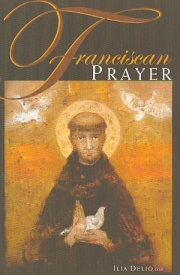
|
Posted November 18, 2004
Book: Franciscan Prayer Author: Ilia Delio, O.S.F. St. Anthony Messenger Press, Cincinnati, OH, pp. 198 An Excerpt from the Jacket:
This is a book on Franciscan prayer written by a theologian who strives to define more clearly the path of Franciscan prayer and as one who seeks God in a complex world. It is my belief that an understanding of prayer in the Franciscan tradition, that is the spirituality of prayer, can offer new vitality to Christian life today because it is a path of relationship with God that strives to live in the fulness of the Incarnation. With exquisite execution, Franciscan theologian Ilia Delio clearly outlines what it means to pray as a Franciscan. Through her experience as a discalced Carmelite nun and then her transformation into Franciscan scholar, Sister Delio brings to light the “contemplative,” “Cosmic” and “evangelizing” aspects of Franciscan prayer. Everyone, says Delio, seems to know about Francis’s life, his miracles, his devotion to evangelization and his dedication to living a simple and humble life, yet few know about his prayer life, which seemed, over the centuries, to get lost in the paper shuffle between theologians, followers and historical biographers. It is through Clare of Assisi, Delio asserts, that we have insights into the Franciscan path of prayer. “[Clare] provides the ‘road-map’ of prayer for evangelical life . . . she was able to do this because she lived under monastic rule while ardently desiring evangelical life.” Through Clare’s letters and actions, we find the rudiments of Franciscan prayer: “Gaze-Consider-Contemplate-Imitate.” An Excerpt from the Book: The God to whom Clare directs us is not one of might and power but a God of self-giving love, a God who has become poor for us. She impels Agnes to gaze upon the God of kenotic love made visible in the crucified Spouse. This is the starting point for prayer – gazing upon the God of self-diffusive love. To gaze is not simply to see. Rather to gaze is to be drawn into the object that one sees. We may liken a gaze to a visual experience of embrace. In his book Exclusion and Embrace, Miroslav Volf describes a “phenomenology of embrace” that may help us understand the power of gazing. An embrace, Volf writes, begins with opening the arms. “Open arms are a gesture of the body reaching for the other. They are a sign of discontent with my own self-enclosed identity and a code of desire for the other. I do not want to be myself only; I want the other to be of who I am and I want to be part of the other.” A self that is “full of self” can neither receive the other nor make genuine movement toward the other. Open arms signify that I have “created space in myself for the other to come in and that I have made a movement out of myself so as to enter the space created by the other.” Volf indicates, however, that one does not stop at the embrace, for the embrace is not to make two bodies one; it is not meant to dissolve one body into the other. If the embrace is not to cancel itself, therefore, the arms must open again; this preserves the genuine identity of each subject of the embrace. Nor should we try to understand the other if we are to preserve the genuine identity of the other in the embrace. If we try to understand the other on our own terms, we make the other into a projection of ourselves or try to absorb the other into ourselves. A genuine embrace entails the ability not-to-understand but nevertheless accept the other as a question in the midst of the embrace, and to let go, allowing the question of the other to remain mystery. Table of Contents: Chapter One: Divine-human relationship Two: Desire Three: Prayer and the spiritual journey Four: Learning to gaze: poverty and prayer Five: Friendship with Christ Six: The heart turned toward God Seven: Contemplation: Seeing and loving Eight: Imitation: becoming what we love Nine: The way to peace Conclusion |
|
